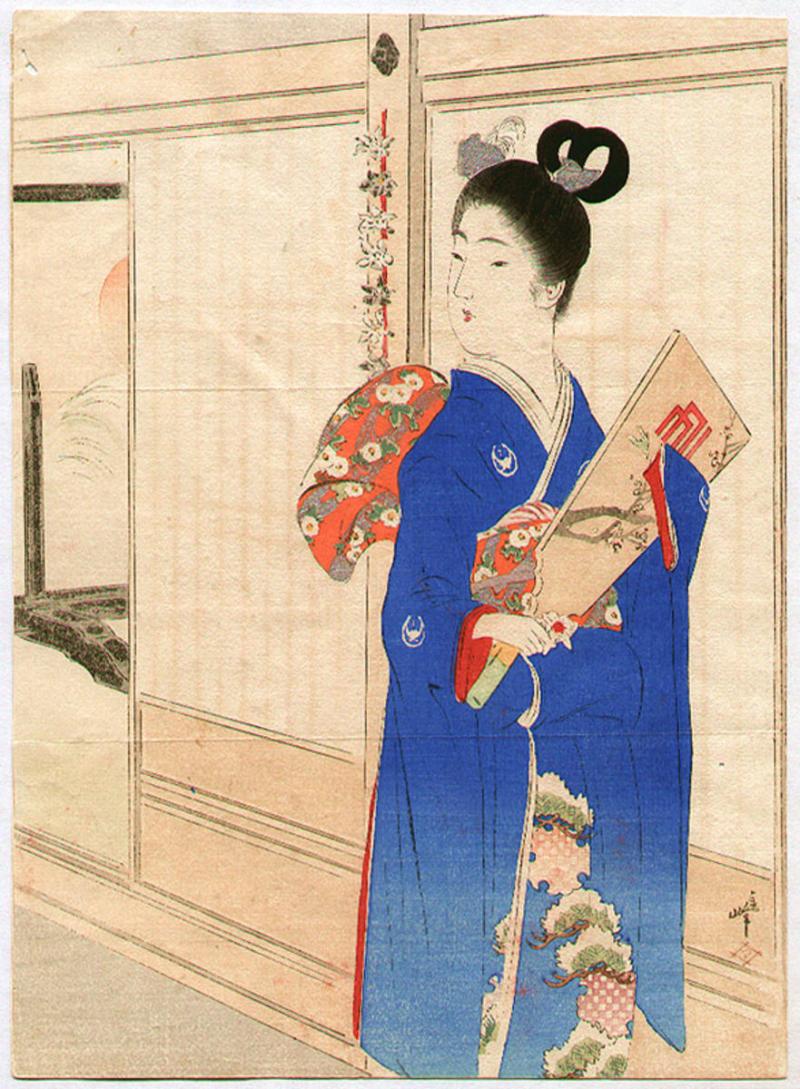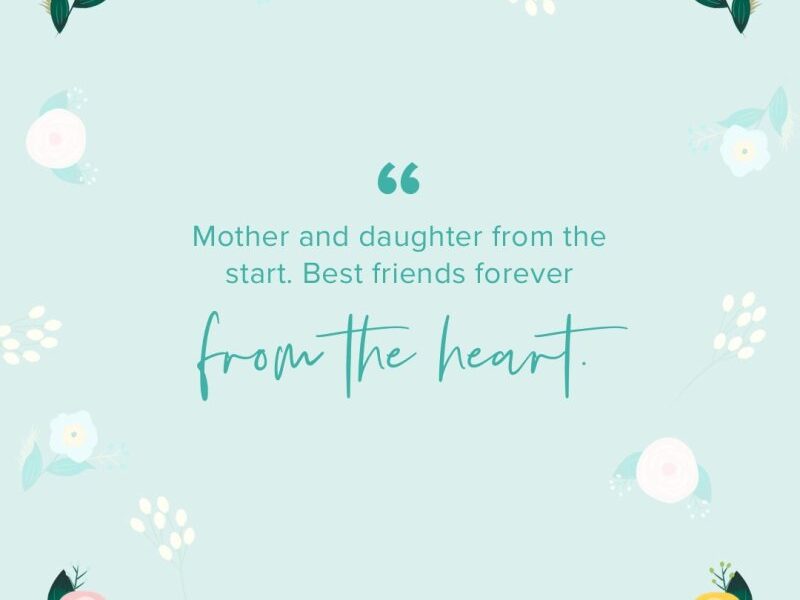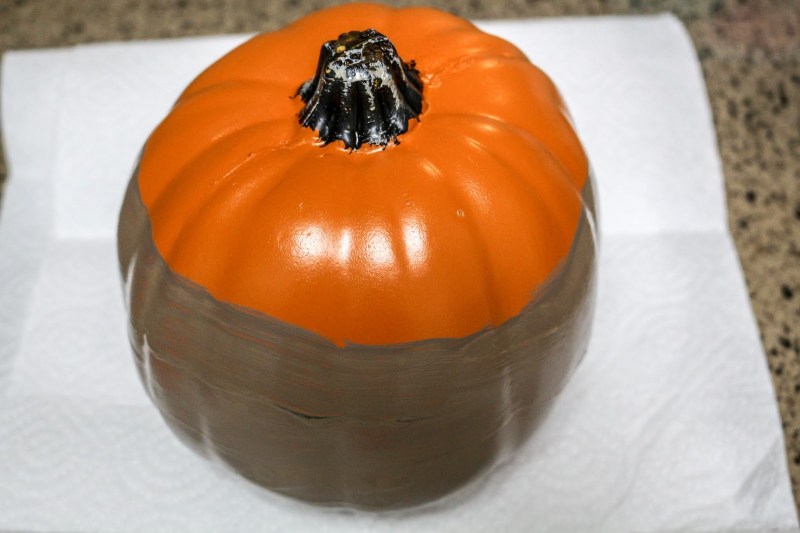Hagoita – The combination of the color of this woman’s kimono (traditional Japanese dress) and the purple color of the background creates a beautiful look. Take a bunch of Japanese wisteria and put it on your shoulder. This flower has been appreciated for a long time, and people like to use it to compose poems. When the Japanese wisteria blooms one after the other, it is thought to show how deep the love is. She shines sweetly with her downcast eyes. His expression is not only attractive, but also creates a mysterious and melancholic atmosphere.
Ume (梅, Japanese apricot blossom) is depicted on the back. Sho-Chiku-Bai (松竹梅) is a popular motif; it is a combination of three plants: pine, bamboo and Japanese beech. Each of them has a good meaning; So people like this pattern. The Um flower is loved as the flower that symbolizes spring.
Hagoita

Note that there are some broken pieces on his arms. The paper pieces of the hair accessories are partially cut.
Japanese Wooden Paddles Hagoita Showa Period
Hagoita (羽子板) is a racket used in traditional Japanese badminton. The Hague has a long history. According to the record, aristocrats and ladies of the court gathered in the palace. They were divided into a male group and a female group and played Hagoita on the fifth day of the new year in the fourth year of Eikyo (永享) (1432) of the Muromachi period. At the same time, people treated Hagoita as a talisman and believed that it would protect them from evil spirits. In temples, Hagoita was used in Shinto rituals. People could have wished for the happiness of Hagoita; therefore, Hagoita would be a perfect gift for the New Year’s game.

Since ancient times, there has been a custom for grandparents or relatives to give Hagoita to their daughter when she receives the New Year. In the past it was not easy to celebrate the first birthday; so that parents or grandparents can pray for the healthy growth of children. Hagoita represents a strong parental love for their children.
When we play Hagoita, we use a special piece. Because it resembles a dragonfly, the Hagoita has been associated with this insect. Pigs eat disease-carrying flies. Therefore, people enjoyed Hagoita to prevent children from being bitten by mosquitoes, which meant that they would be disease-free.

Sensōji Temple Hagoita Ichi Fair, 17th Dec–19th Dec, 2023
During the Edo period (1603-1867), Oshie (押絵) technology was developed. Pieces of paper were glued to cardboard supports or cotton was wrapped around fabric to make thick pieces. And then, these parts were combined to create a three-dimensional image. The name of this work is Edo Oshie-Hagoita (江戸押絵羽子板).
Kabuki (歌舞伎, a traditional form of Japanese dramatic performance) became popular during the Bunka Bunsei (文化文政) period (1804-1829), and Hagoita reproducing the Kabuki scene became fashionable among ordinary citizens. Since then, the decorative beauty of Hagoita has been followed. Oshie’s technique evolved over time, and Yakusha-Hagoita (役者羽子板, actor Hagoita) made by Kabuki actors or women wearing Furisode (振袖, a type of kimono; traditional Japanese clothing), became an explosive seller.

For the creators of Oshie-Hagoita, it was not easy to express the dynamic movements of Japanese or Kabuki dance on a small limited trapezoidal table. They worked hard and thought hard to get it. In addition, each Oshie-Hagoita has a different makeup and facial features based on the trend of each era. Oshie-Hagoita is a work of art that expresses itself in detail.
Kunisada, Hagoita Of Sawamura Tossho As Jiraiya
The makers of Oshie-Hagoita have inherited the traditional techniques and continue to make Oshie-Hagoita. Nowadays, we can find them in various sizes, as wall decorations or desktops. Oshie-Hagoita considered it a lucky gift for a birthday celebration, or Kabuki fans enjoyed it as their own collection.

The Doll Museum in Kanazawa, Japan displays over 600 traditional Japanese dolls. We display a variety of Japanese dolls, such as ICHIMATSU dolls, Hina dolls, and Kokeshi dolls, all of which are cute and beautiful to see in person. We also carry freshly handmade Japanese dolls in our gift shop. Now, due to popular demand, we have started selling our products on the internet. Thank you very much for checking out our list items.
We accept payments with Stripe (credit card), PayPal, both secure payment methods. If you prefer another payment method, please contact us. After confirming your payment, we will apply for an export permit. You can pay in JPY or USD. The price is set in Japanese yen. Prices in other currencies are automatically calculated based on the latest exchange rate.

Japanese Hagoita With Oriental Lady Embellishment…wood Framed
We usually ship via EMS (Express Mail Service) provided by Japan Post. It usually takes at least 5-14 days to deliver the package after placing the order. We will use DHL instead for those ordering from the US or Australia as EMS is temporarily suspending shipping to these countries due to COVID-19. We offer free international shipping as long as we can ship your order by EMS or DHL. (US, Australia only)
We will notify you by email of the order tracking number. Make sure you enter your valid email address correctly.

*Please note that due to the spread of COVID-19, there may be shipping delays. If you want to know the details about shipping, please ask us.
Takeuchi Keishu: Hagoita (battledore)
Want to see more Oshie Hagoita for sale? Check out the link below. We hope you can find your favorite Oshie Hagoita.

This site uses cookies to improve your experience. We’ll assume you’re fine with this, but you can choose not to if you want. ACCEPT cookie settings
This site uses cookies to improve your experience while browsing the site. Of these cookies, cookies that are classified as necessary are stored in your browser because they are so important to the operation of the basic functions of the website. We also use third-party cookies that help us analyze and understand how you use this website. These cookies will only be stored in your browser with your consent. You also have the option to disable these cookies. But the choice of some of these cookies can have an impact on your browsing experience.

File:hagoita Onsale Zoomin Asakusa Dec2014.jpg
Cookies are absolutely necessary for the website to function properly. This category only includes cookies that ensure the basic functions and security features of the website. These cookies do not store any personal information.
Any cookie that may not be specifically necessary for the operation of the website and that is used specifically to collect personal data from the user through analysis, advertising, other embedded content, is called non-necessary cookies. Before using these cookies on your website, it is necessary to obtain user consent. With KCP International, you can earn more Japanese credits than a full year at your university. Plus, you get to choose your start date!

Immerse yourself in the heart of Tokyo with a variety of courses, flexible schedules and convenient packages that make your experience easy.
Hagoita One By Ella Joosten (2010)
Hagoita (羽子板 「はごいた」) are Japanese wooden paddles used in the traditional game of hanetsuki (羽根突き, 羽子突き). The game, somewhat like badminton, is usually played at Christmas.

Hanetsuki may have waned in popularity over the years, but hagoita with their intricate designs are still in high demand and a decorative element in many Japanese homes.
Hagoita are usually square, lacquered with traditional Japanese symbols and characters from kabuki dramas and decorated with silk collages. The origins of the Japanese tradition of playing hanetsuki with hagoita go back to 14th century China. The game came to Japan during the Muromacho period (1337-1587). The ancient document “Kanban O-nikki” describes Hanetsuki as interpreted by the Imperial Court.
Hagoita Of Kids
The ancient Japanese believed that diseases could be transmitted by mosquitoes that ate dragonflies. The girls in the Hanetsuki game look like dragonflies. The Japanese started playing at Christmas to prevent their children from attracting mosquitoes.
The hagoita was also believed to ward off evil spirits during the Sengoku period (Warring States Period) from the mid-15th century to the early 17th century. It was during the Edo period that wooden sticks gained popularity as gifts to wish family and friends in the new year and for girls to wish good luck in their first new year.

Every late December, Hagoita-Ichi (Battledore Fair) is held at Senso-ji Temple, Asakusa, which is one of the most popular places in Tokyo. Many hagoitas of different sizes and designs are sold every year at dozens of market stalls there.
Hagoita Market In Asakusa
Tips for living on a food budget for students in Japan Tokyo, the capital of Japan and home to KCP International Japanese Language School, is a bustling metropolis that ranks as one of the busiest cities in the world … Read more

Why study in Japan? The world has become smaller in the sense that people from different countries are connected to each other through technology. KCP Flickr Is… Read more
We love to share ideas and experiences that our students find in Japan. If you want to submit content for our blog, enter here!

Good Luck Charms For The New Year, Hagoita
KCP International Japanese Language School has been training students since 1983. Join students from around the world for the full Japanese experience. The color combination of this woman’s kimono (Japanese traditional dress), mainly red, gold,
Hi speedroid hagoita, hagoita yugioh, hagoita for sale, speedroid hagoita, hagoita paddle



